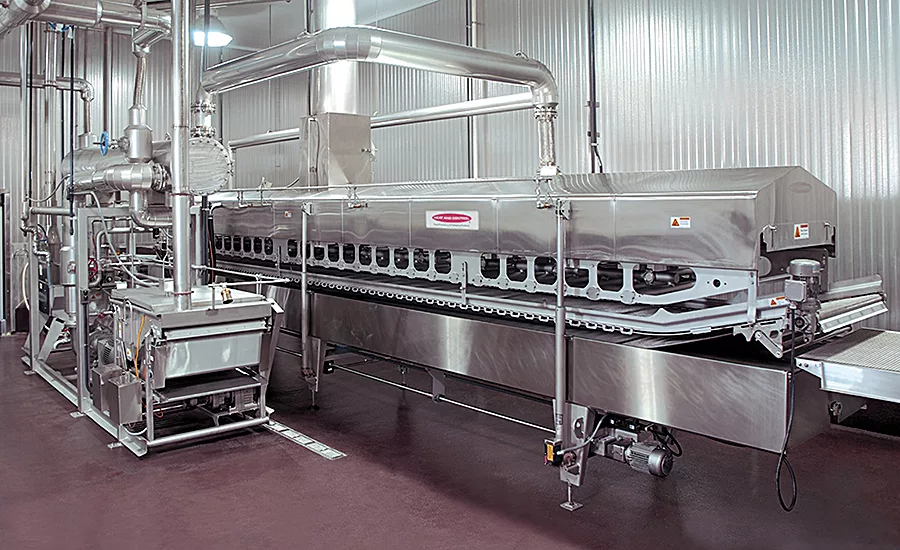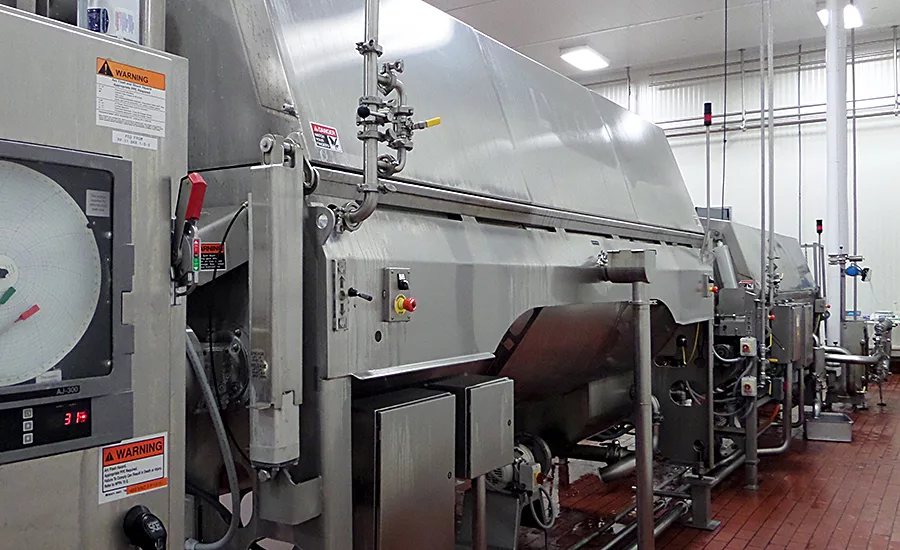Protein Processing
Solving meaty challenges
Protein processors can have trouble meeting production demands, if they’re working with out-of-date manufacturing spaces and equipment.

This fryer from Heat and Control has an external support module, which contains oil filters, pumps, a heat exchanger and oil makeup/storage tank, pre-piped and mounted on a skid for easy access to all the components for cleaning and maintenance. Source: Heat and Control, Inc.

When all team members talk to each other and the coach, much more can be achieved. The same is true of a production line. Machines in communication with each other and with a central control system are more productive. Source: GEA Group.

To minimize risk, forklift traffic routes should be kept separate from personnel traffic; interstitial spaces (access shown in rear) can be used for piping and conduits. Source: Curtis Waltz, Aerialscapes.

The CRYOLINE CW IQF tunnel freezer features (A) fully welded SS sloped surfaces, (B) continuous operation with surfaces that easily drain liquids, (C) a CIP-ready belt-washing option, (D) internal sloping sides, (E) a top that raises for cleaning and maintenance, (F) rolling-wave belt and (G) auto-logging of operating parameters. Source: Linde LLC.

Featuring built-in CIP, the Lyco Clean-Flow continuous water blancher/cooker/cooler works in one- or two-zone configurations. The machine can blanch, cook or rehydrate in one zone, cool in a second zone or be a standalone cooler in a separate machine. Source: Lyco Manufacturing.
While many protein processors need to speed up their operations, there are many stumbling blocks thwarting their efforts. For example, the processing equipment is maxed out, and not a single machine on the line communicates with another, making any kind of line synchronization or performance improvement next to impossible. In fact, some older machines are difficult to keep clean and downright dangerous. Plus, the manufacturing space may be cramped with “head-knockers,” is drafty and/or has poor drainage and humidity control. During washdowns, the monsoons set in and reduce visibility to near zero, with condensation everywhere.
Article Index:
- Greenfield facility requires planning
- Plant design ideals
- Equipment: From freezers to fryers
- Making equipment safer and cleaner
- Automating the line
Although this picture may be a bit exaggerated, you probably face some of these issues yourself, unless you’re lucky enough to have just taken the reins of a brand-new greenfield facility. Thankfully, solutions are available, if you can’t leave your building any time soon. Of course, you must be prepared to make some investments in your equipment, facility and employee training. Just look at these expenditures as an investment in throughput, worker safety and food safety.
Greenfield facility requires planning
Kyle Lawrence, Stellar process project manager, recalls one poultry processor whose product demand was growing by leaps and bounds. The processor had grown out of its one facility that was used for slaughtering, processing, refrigerating, packaging and sending off raw product to a co-packer for further processing. To get more control over its cooked products (tenders and nuggets), the processor wanted to do further processing, but where?
First, the processor purchased land a mile down the road from its existing facility. Then, it contracted Stellar to design and build a new facility to do the further processing its co-packer was handling. According to Lawrence, the Stellar team worked with the processor to plan the rooms and characterize the flow of people within the plant. It also looked at the product flow: how and where raw product would be coming in, where it would be stored, the frequency of product movement from storage to processing, the processing steps and the storage of cooked/finished goods. The airflows were planned, refrigeration system designed and a right-sized HVAC system engineered to keep condensation from occurring. All the automated equipment purchased for the site has a sanitary design and lock-outs/tag-outs for maintenance and cleaning, minimizing employee risks.
The secondary packaging and palletizing are heavily automated with robotics so workers don’t continually have to lift 40- to 50-lb. cases of product. The erection of boxes for finished goods is handled automatically, with the boxes sent to any of nine lines. Completed cases on each line are sent to the palletizing area, where they are sealed, labeled and stacked on pallets.
The entire facility was designed with 3-D tools, allowing the Stellar team and the processor to “walk through” the plant to get a feel for how it would function with people and operating equipment inside. The software tools also revealed any “clashes” of construction design, for example, an air duct placed so high it would “penetrate” an I-beam.
“Revit and Navisworks are two programs we use to produce building information models [BIMs], or 3-D representations of a facility,” says Tyler Cundiff, Gray Construction director of business development—food and beverage. “Our engineers, architects, project managers and subcontractors use the BIM model to conduct clash detections and evaluate sanitary noncompliances in a space before construction begins. We also use virtual reality technology that provides a fully immersed plant experience and walkthrough, which has proven to be very useful to plant engineers and maintainers in particular.” By being able to explore and review the facility during the design phase, these individuals can experience small details and nuances they may overlook when reviewing 2-D drawings or even a 3-D model.
Plant design ideals
For new facility designs, it’s all about continuously improving best practices. “Best practices are implemented into our quality management programs to enhance overall project quality, ‘clean design’ and ensure food safety awareness,” explains Cundiff.
Gray Construction supports protein processors by recommending clean-build best practices, which include, for example:
- Process flow of materials through the building
- Use of easily cleanable materials, i.e., stainless steel, resinous flooring and plastisol
- Pressurization mapping to keep the raw and cooked environments separated
- Physical separation between raw and cooked materials.
In addition to designing for food safety, an A&E/C firm should have a dedicated auditing system for sanitation safety and the necessary checks for construction material handling, process systems piping and systems commissioning. Cundiff’s firm gives each project subcontractor a copy of “Gray’s Contractor Guidebook for Food Plant Construction” to help ensure food safety and sanitary practices are followed.
“As a design-build engineering firm specializing in food processing and distribution facilities, we work with owners and equipment manufacturers to isolate the red-line areas from other building functions and provide security systems to prevent unauthorized personnel access,” says Jack Michler, ESI Group USA Midwest regional manager. “We also promote installing mechanical piping in interstitial spaces to avoid the daily cleaning of the piping systems and allow routine maintenance without disrupting process operations.” Clean-in-place equipment is critical, and for mobile processing equipment, clean-out-of-place washdown rooms should be provided.
Washdown consideration is just as important in a renovation as in new construction. “Washable elements are necessary for food processing facilities,” says John Koury, A M King director of architecture. “Knowing this up front is crucial to the execution of a renovation. If the design makes spaces easy to wash down, then naturally, they are going to be washed more frequently, thus supporting overall food safety.”
In addition, all construction materials and finishes in a process must be cleanable, noncorrosive, nontoxic, nonabsorbent and able to withstand thermal shock during the cleaning cycles, adds Michler. Plus, adequate drainage, hygienic ventilation systems and accessibility provisions should be designed to eliminate any potential for moisture buildup that could harbor pathogens.
Whether it’s a matter of new construction or retrofitting an existing structure, the design of loading docks and exterior doors should make it difficult for pests to gain access, keep outside air out and facilitate cleaning, advises Koury. “High-speed automatic doors with sensors help preserve cool conditions and control pest penetration. Properly designing and installing a loading dock system with state-of-the-art, drive-through capabilities and vertical storing levelers, along with routine maintenance of the system, will not only decrease exterior exposure, they will continue to decrease this exposure for years to come. Since the areas in the dock pit are difficult to reach and clean, specifying a dock with clear space beneath the anchor points also is important.”
Maintaining the correct air pressure is one of the more critical food safety issues at a protein processing facility—especially with renovations, notes Koury. “The utilization of pressure monitors from room to room is vital for this type of renovation. With monitoring, pressure can be protected and addressed as soon as possible, decreasing the probability of compromising foods.”
Protein processing plants are notoriously dangerous places to work; they’re often cold, damp and slippery. “Obviously, any moving equipment must be guarded against personnel accessibility,” says ESI Group’s Michler. Therefore, guarded traffic aisles and security access measures need to be provided to prevent employee access to fork truck or material handling equipment and eliminate access to process areas by non-authorized personnel. In addition, all electrical equipment in washdown areas must meet NEMA ingress standards. And, switchboards, panelboards and motor control centers should be located in secure non-washdown rooms, says Michler.
“We review the accessibility points for maintaining equipment safely,” says Cundiff. “It is important to allow for removable panels and access to install additional equipment on multiple levels. Our team reviews equipment layouts in three dimensions with both the end-user and equipment vendors to ensure access and egress to and from the equipment meets all OSHA standards and is aligned with facility aisles and work spaces. In some cases, the facility is designed to meet OSHA requirements from the beginning. However, the ingress/egress requirements from the local jurisdictional authorities may be overlooked when it comes to equipment layout.”
Equipment: From freezers to fryers
Since production line freezers use conventional refrigerants or cryogenic gases, processors must determine which type of freezer will work best with their application. For example, cryogenic-based tunnel freezers typically are smaller and simpler in design than their spiral counterparts.
Air Products and Chemicals sells and leases a wide variety of liquid nitrogen-powered cooling and freezing equipment. “Because liquid nitrogen is so cold [-320°F] and can carry away up to 140 BTU/lb., continuous freezers powered by liquid nitrogen are always the smallest option for a given throughput,” explains Chris Johnson, marketing manager, Food-Americas at Air Products.
“A small freezer carries with it a number of benefits in protein processing, especially in the context of food and employee safety,” adds Johnson. He lists four advantages of smaller freezers that also apply to other pieces of equipment in general:
- A smaller piece of equipment means fewer surfaces and less surface area to clean.
- A smaller piece of equipment is typically easier to clean due to fewer and smaller food contact surfaces, as well as easier-to-reach surfaces.
- Smaller equipment allows swabbing and testing to be more thorough.
- Smaller equipment means a very fast freeze. Food is frozen in a few minutes rather than dozens of minutes, thereby minimizing the time that food spends in the “FDA Danger Zone.”
Cryogenics can be applied for chilling applications, too. For example, Linde LLC offers CO2 snow generators to chill food products in boxes and tote bins; combo chilling systems for the repeatable temperature reduction of cut poultry and finely textured pork; and advanced ACCU-CHILL bottom injection systems to chill ground protein products in mixers/blenders, according to Mark DiMaggio, head of food and beverage. “On the freezing side, we manufacture hygienically designed spiral freezers and tunnel freezers, the patented Linde impingement freezer and the proprietary CRYOLINE CW rolling-wave freezer for IQF, plus a number of other freezing systems.”
In addition to cryogenic freezing and chilling systems, Linde offers food-contact gases for modified atmosphere packaging systems. These systems can typically extend the shelf life of chilled red meat by a factor of two compared to packaging in air, says DiMaggio. For raw fish, it is typically a factor of two or three and, for light poultry, a factor of three to four.
“Protein processors understand the quality of food-contact gases is an integral part of their decision when they adopt cryogenic technology,” states DiMaggio. “Under 2015 FSMA requirements, food-contact gases are now regulated as food ingredients and must be managed up the supply chain. And, production, packaging, handling and storage must all be fully documented using hazard analysis and risk-based preventive controls [HARPC].”
It’s important to note that cryogenic processing equipment must be vented to outside air; automated systems typically include integral hoods to vent gases. Plus, inline freezers may include safety plenums at entry and exit points. Maintaining a pressure balance inside the freezer during operation minimizes the escape of cryogenic gases into the work environment and maximizes cryogenic efficiency, adds DiMaggio.
Today’s processing equipment is becoming more automated, faster, safer to operate, hygienically designed for food safety and more connected. Daniel Plante, JBT Corporation director of sales and marketing—North America, points out some refinements. “Automation inherently limits human interaction, therefore increasing safety within the plant. JBT believes in hygiene by design, with features such as sloping surfaces, open-channel support structures, limiting [the use of] capped rails and reducing niches.” For instance, the GYRoCOMPACT self-stacking belt spiral freezer has an architecture that helps eliminate nearly 90 percent of the support structures in a typical structurally supported system, making the oven easier to clean.
Making equipment safer and cleaner
Processing equipment such as fryers, cookers and slicers can present a number of potential risks to employees and property. Consequently, suppliers are designing equipment to meet new safety criteria. For example, JBT has begun using voltage separation technology for control panels, isolating the high-voltage components from the low-voltage devices, says Plante. In addition, the new JBT model TFF-V fryer is equipped with emission-suppression technology, minimizing oil residue in the exhaust system, which can often be the cause of roof fires.
“There is a need for cleaner installations, especially in the area of fryers,” says James Padilla, Heat and Control, Inc. director of product development. To simplify sanitation and maintenance and reduce installation time, Heat and Control developed a fryer support module. “Oil filters, pumps, the heat exchanger and oil makeup/storage tank are mounted, pre-piped and wired on a skid that includes an oil catch pan to prevent oil spills,” continues Padilla. “This design allows easy access to all the components for cleaning and maintenance. The module takes up minimal floor space and improves safety by reducing complex piping runs and debris catch areas.”
The Lyco Manufacturing Clean-Flow continuous flow rotary drum water blancher/cooker/cooler can work in one- or two-zone configurations, and has built-in CIP to simplify cleaning. “It can blanch, cook or cool in one zone, cool in a second zone or be used as a standalone cooler in a separate machine, and the continuous flow capability ensures a uniform cook/chill experience for the product,” says Gary Corzett, vice president, sales & marketing. “CIP capability comes with every Lyco product. The CIP cycle is completed in minutes with almost no manual involvement, and our CIP systems have strategically located spray nozzles and spray balls to cover 100 percent of the targeted areas for proper, effective CIP. Slide-out chutes and in-feed/discharge components [are available] for full access and visibility on all machinery.” The Clean-Flow unit includes two emergency stop switches as well as safety pull cables, two-hand safety switches for the covers and two-hand jog modes for the rotating devices needed during CIP cycles.
Automating a single operation such as portioning meat improves food safety and reduces operator accidents and fatigue due to repetitive motion. “JBT’s scanning technology and portioning equipment nearly automate this process completely. OSHA regulations drive the equipment safety design,” says Plante. “Additionally, food safety can be enhanced through automation in several areas, the obvious one being the reduction in manual handling of products, which keeps operators’ hands from touching food products, reducing the risk of contamination.”
Access for maintenance and inspection also is critical for plant safety and is a top priority in any JBT design updates, according to Plante. For example, the company has moved the main fan motors in its Jet Stream and GYRoCOMPACT ovens to the outside of the main enclosure. In addition, the supplier now has standard 40-in. line widths to ensure employees can safely reach from one side to the center of the belt. “JBT keeps OSHA regulations in mind when designing safety components on all our equipment,” says Plante. “Our customers are typically governed by the USDA, and we consistently listen to their feedback. Key design changes are initiated based on that feedback and are made to ensure our customers’ equipment is ideal in the minds of the USDA.” The company also provides some equipment with 3-A dairy standards, if needed.
Automating the line
Automation not only reduces repetitive human tasks, it can help maintain quality and food safety. “Automation can be deployed to monitor and control critical control points such as product and process temperature,” offers Plante. Food processing is traditionally a labor-intensive sector, and one that relies heavily on the expertise of the people involved. Fortunately, this expertise can now be embedded in the control system. Alex Strolenberg, director of sensor solutions for GEA, says, “Our customers want processes to be easier to manage, more efficient and, therefore, more cost effective. These are the drivers for our automation program, and new developments are steered by working together with customers. The emphasis has shifted from how to automate a process from a machine perspective to why it needs to be automated and what value it adds for the food processor.”
GEA automation systems are based around four modules that can be extended in terms of functionality, connected machines and client connections. The four modules are: Link Logic (linking machines together), Process Manager (a storage platform for process data), Production Commander (production automation) and Plant Controller (advanced functionality and enterprise resource planning [ERP] interfacing).
“When each machine in a line operates independently from the others, process-critical operations, such as initiating startup and getting machines up to the operating temperatures, take a lot of time and manpower,” says Strolenberg. Walking from machine to machine to load programs is also a potential source of errors. And, products can be wasted if one machine in line stops functioning, while other upstream machines continue operating. Therefore, it is absolutely essential to intelligently link machines together.
How is the return on investment (ROI) on an automation solution quantified? “Because automation brings many ‘soft’ improvements, it’s a challenge to put an exact figure on the potential savings,” replies Strolenberg. For example, the reduction in a labor-intensive task such as data collection does not just comprise the hours required to collect data; it also entails the time required to analyze it, generate reports and make the information available. These hours are rarely itemized in a spreadsheet column. Another example is an automation system that significantly reduces the likelihood of errors including wrong labels, wrong ingredients and so on. How do you quantify the savings of avoiding these mistakes?
Another intangible benefit of automation is the strengthening of customer relationships, due to factors ranging from more transparency into your operations to faster response times and better service, says GEA’s Strolenberg.
What’s in the future for automation? “New technologies and trends are influencing the direction automation is taking,” answers Strolenberg. “The traditional hierarchical structure of automation, with machines at the lowest level and ERP systems at the top, will gradually give way to a peer-to-peer approach. This is in line with the Internet of Things [IoT] philosophy and infrastructure, also referred to as the fourth industrial revolution [Industry 4.0]. With the peer-to-peer approach, data no longer needs to travel up and down the hierarchy but directly from one intelligent node [or peer] to another.”
As a result, performance improvements can happen at the line level through peer-to-peer communications and decision-making. “Today’s automation can already do these things, but it will become simpler and more versatile as intelligent nodes for IoT are integrated into the relevant places in equipment,” concludes Strolenberg.
For more information:
Kyle Lawrence, Stellar, 904-899-9377,
klawrence@stellar.net, www.stellar.net
Tyler Cundiff, Gray Construction, 859-281-5000,
tcundiff@gray.com, www.gray.com
Jack Michler, ESI Group USA, 866-369-3535,
jmichler@esigroupusa.com, www.esigroupusa.com
John Koury, A M King, 704-365-3160,
jkoury@amkinggroup.com, www.amkinggroup.com
Chris Johnson, Air Products and Chemicals, 800-654-4567,
gigmrktg@airproducts.com, www.airproducts.com/food
Mark DiMaggio, Linde LLC, 800-755-9277,
mark.dimaggio@linde.com, www.lindefood.com
Daniel Plante, JBT Corporation, 800-653-0304,
dan.plante@jbtc.com, www.jbtcorporation.com
James Padilla, Heat and Control, Inc., 510-259-0500,
jamesp@heatandcontrol.com, www.heatandcontrol.com
Gary Corzett, Lyco Manufacturing, 920-623-4152,
gary.corzett@lycomfg.com, www.lycomfg.com
Alex Strolenberg, GEA Food Solutions, +31 492 349 349,
alex.strolenberg@gea.com, www.gea.com
Looking for a reprint of this article?
From high-res PDFs to custom plaques, order your copy today!









